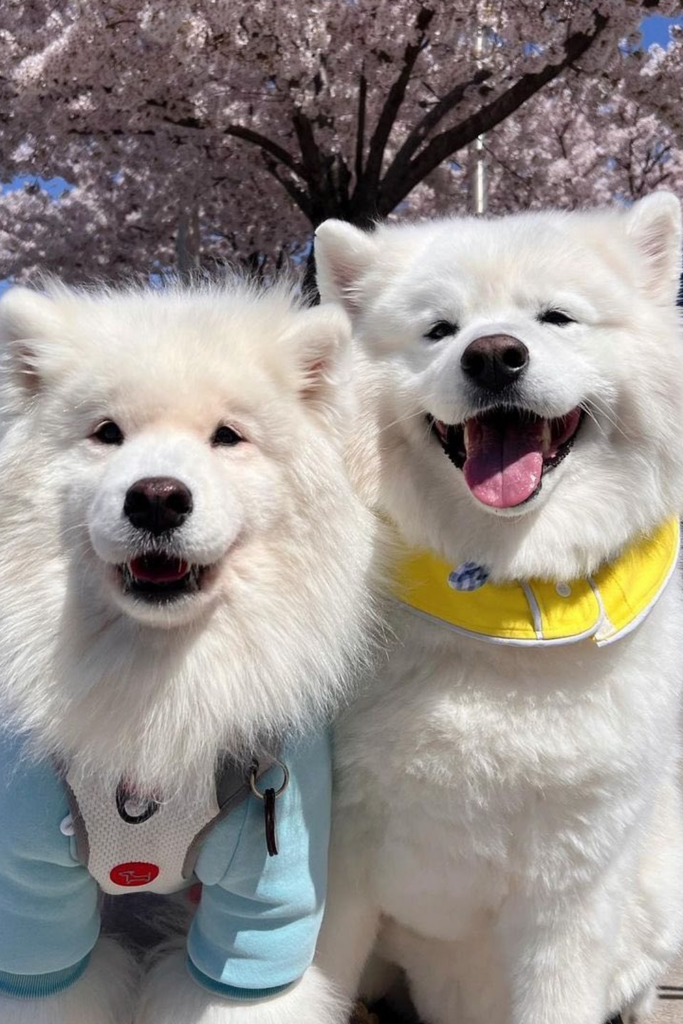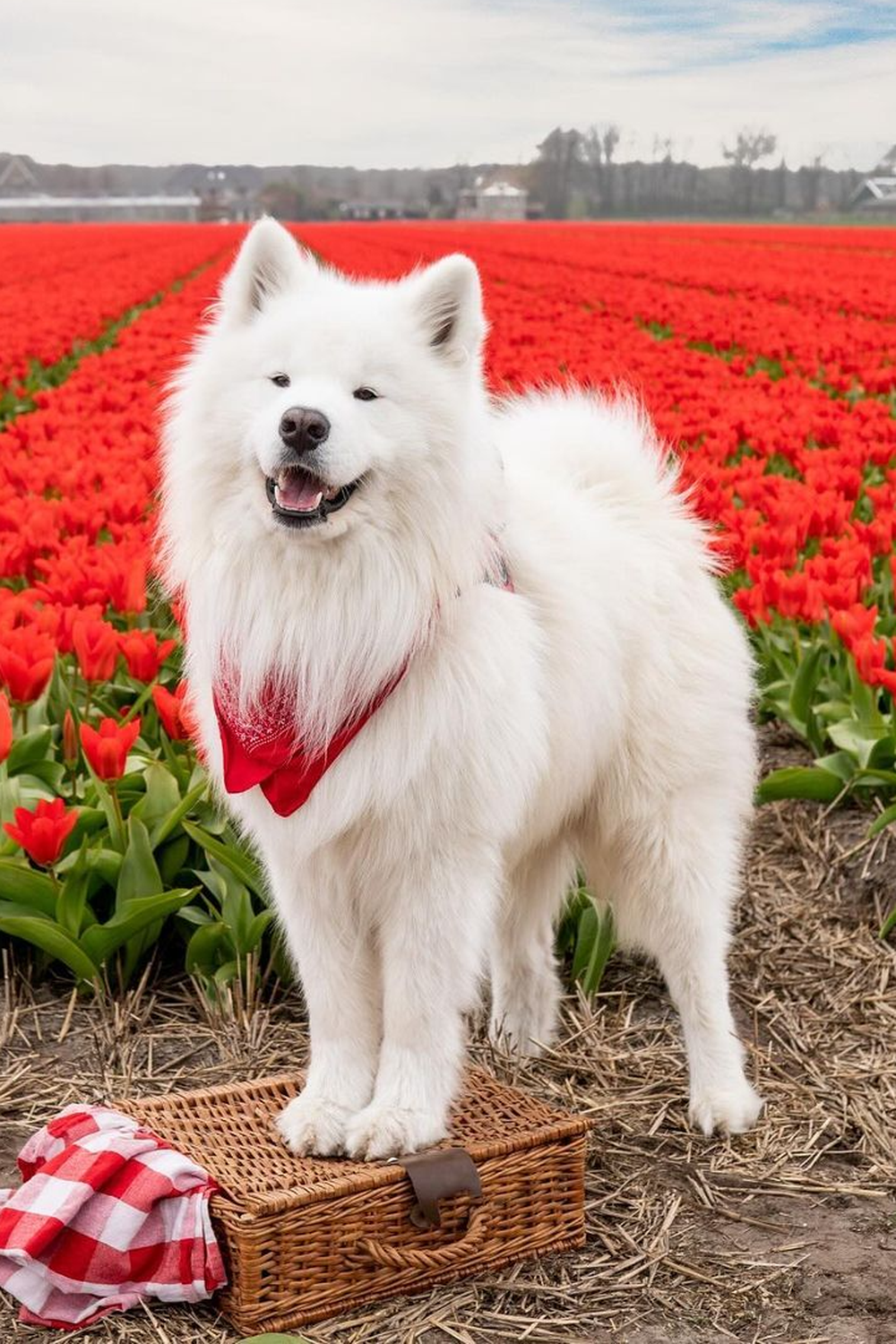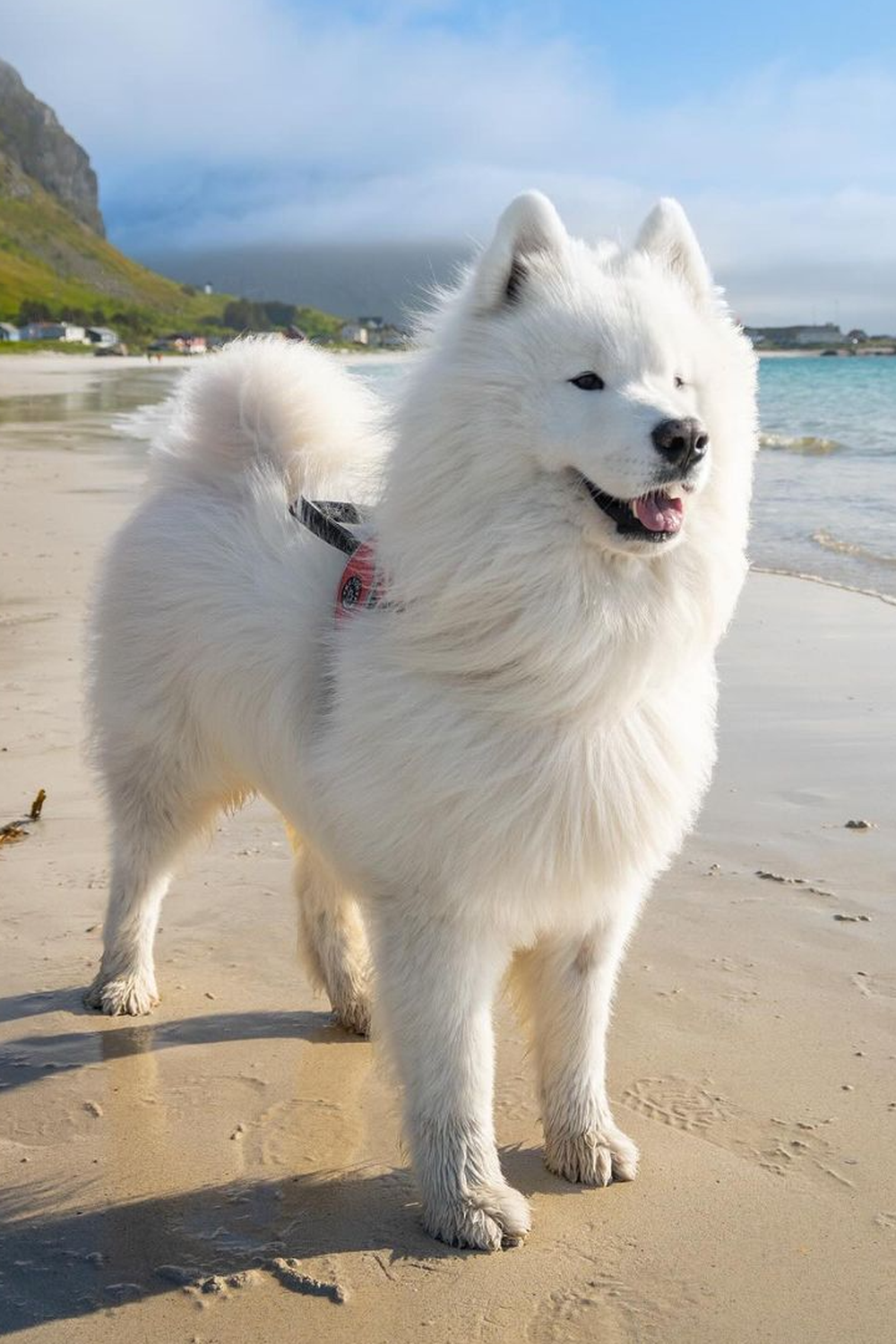We're an affiliate
We hope you love the products we recommend! Just so you know, we may collect a share of sales or other compensation from the links on this page at no additional cost to you. Thank you if you use our links, we really appreciate it!
The Samoyed is a beautiful, gentle, and trusty working dog breed with a highly spirited body that can do well in physical activities.
The Samoyed dogs, or ‘Sammies’ can be independent at times but they always crave human attention in most things they do.
Due to their historical background in Siberia, Sammies are highly optimized to withstand the chilly weather in tough winter.
But despite their inherent nature to perform work, these fluffy dogs are more than happy to lounge in households as family pets so long as they get enough opportunities to play.
Keep reading this blog to discover relevant Samoyed dog breed info including their history, characteristics, grooming needs, and much more.
Brief History About Samoyed Dog Breeds
The Samoyed dog breeds were named after the semi-nomadic Samoyedic people of Siberia, who heavily relied on these dogs for herding reindeer, hunting bears, and pulling sleds.
These workaholic dogs were treated as members of the family by the native Samoyedic people, and they even stayed together in their primitive dwelling places to keep their owners warm.
It is due to this closeness and kind gesture that the Samoyed dogs developed the kind and well-natured attitude that we see today.
Some polar explorers from Europe discovered these amazing canines around the mid-1800s and were quick to tag them into their expedition across the seas, bringing some back to Egland.
The newly brought Samoyed dogs became a favorite breed among the English elite, who loved their regal appearance and friendly attitude.
Queen Alexandra of Denmark loved the Samoyed dogs, and it is believed that many modern-day Sammies across the UK and the US descended from her kennel.
The first Samoyed dog breed to be inducted into the American Kennel Club received recognition in 1906, a move that increased the popularity of these beautiful canines.
5 Facts About Samoyeds That You Probably Didn’t Know
1. Samoyeds seems to be ever-smiling
One of the most charming facts about the Samoyed dogs is that they appear to be smiling all the time, a trait which has earned them the nickname ‘smiling Sammy’.

It’s important to know that there’s a valid explanation behind the perpetual smile from your lovely Sammy Furball.
These regal canines have been selectively bred to have a black muzzle that is rounded off the corners of their mouths to prevent drool from forming icicles around the mouth area.
2. Samoyeds blow their coat twice a year
The magnificent double coat of Samoyeds is beautiful to look at and touch but keep in mind that these dogs experience two heavy shedding seasons a year.
Despite their tendency to put away lots of furs, Samoyeds can be a good choice for individuals with allergies because they don’t produce too much dander like most dogs.
3. They excel in competitions
Samoyeds are not just about their pretty face and regal appearance, they are indeed clever dogs who can participate and excel in various competitions thanks to their enduring spirit.
These workaholic dogs have won titles in canine speed competitions, and they can also do extremely well in pulling sleds and herding events.
4. Samoyeds have a genetic connection with wolves
Although they have undergone extensive breeding from the past, modern-day Samoyeds, and 13 other ancient dog breeds, still have a genetical linkage with wolves.
5. Samoyeds are energetic dogs
A Samoyed dog might be a perfect fit for families looking for energetic companions to keep up with an active lifestyle.
These dogs were bred to get the work done, and they still have the enthusiasm to participate in outdoor activities.
Your Smiling Sammy will be more than happy to assist you in a few tasks, but be cautious not to overexcite them.
Samoyed Puppies
Welcoming a Samoyed puppy into your household is an exciting experience that comes with a fair share of responsibilities.
Make sure to puppy-proof your home and invest in a variety of accessories to keep your fluffy pup contented in their new home.
Samoyed puppies are naturally attuned to people, so they will be glad to take part in obedience training, socialization, and interactive play sessions.
These magnificent canines can be independent, but they don’t do well when left alone for extended periods.
Samoyed Physical Characteristics
Size and Weight Range
A fully grown male Samoyed dog has a shoulder height of about 23 inches while their females may come a few inches shorter.
In terms of weight, an adult male Samoyed can tip the scale to about 45 – 65 pounds, whereas a healthy female can have a range of 35 – 50 pounds.
Coat color and Texture
Samoyeds are covered in a dense, double-layered coat that works to provide insulation during the cold weather. The outer coat is straight-haired and the inner coat is soft, thick, and woolly.
Samoyed’s snow-like coat is predominantly bright white, giving the dog a semblance of fluffy clouds. Other accepted colors of Sammies include biscuit (light brown) and cream.
Distinctive features
One of the most distinctive features of the Samoyed dog breed is the perpetual smile that comes from their upturned lips.
Samoyeds can also be distinguished by their erect ears, making them an alert companion in your home.
Samoyed Temperament and Personality
The ‘Sammy Smile’ gives the Samoyed an easygoing and lovable personality which stems back from their days in Siberia where they lived within close quarters with their human companions.
The inherent playful nature makes the Samoyed an adorable breed for first-time owners and those with younger kids.
These beautiful canines can also get along with other pets and they also extend their well-natured temperament to strangers.

Samoyeds have an inherent drive to chase prey, so you may have to offer some basic training if you keep smaller pets.
Because of their high energy and desire to perform tasks, Samoyeds are preferable for active owners who can take them out for regular outdoor expeditions.
Samoyed Intelligence
Samoyed dogs are smart! They have medium-level intelligence, according to Dr. Stanely Corren who found them to be number 44 out of 138 dog breeds tested for working and obedience intelligence.
The impressive IQ of Samoyed stems from their inherent ability to learn new tricks and perform different tasks while learning from their previous mistake.
Samoyed Lifespan
The average lifespan of a Samoyed dog is between 12 to 15 years with considerable exception witnessed among individual dogs.
Providing proper care right from puppyhood into adulthood and throughout senior life can extend the life expectancy of your Samoyed by a few more years.
Samoyed Common health issues and genetic disorders
Samoyeds are regarded as a generally healthy breed, but that is not a clear bill that an individual dog may not have some health issues.
The following are some of the conditions to watch out for if you are parenting this dog or you intend to adopt one:
- Hip Dysplasia
- Glaucoma
- Diabetes Mellitus
- Sub-valvular Aortic Stenosis
- Progressive Retinal Atrophy (PRA)
- Hypothyroidism
We strongly recommend taking your Samoyed dog to a qualified vet for a timely check-up in case you see any signs of ill health.
Preventative Measures for Good Health
Before picking your Samoyed puppy from a breeder, you need to be certain that the puppy does not come from a lineage of sickly parents.
A responsible breeder should screen the parents for any inherited condition that could affect the upcoming generation.
If you’re adopting a Samoyed from a rescue organization, it’s also prudent to ask for the dog’s family medical history to be aware of the potential challenges in health.
The other thing you can do to improve your dog’s health is to provide a balanced diet and a consistent supply of clean drinking water.

Your Samoyed dog will be happy to have a job to do. Make sure to provide sufficient physical and mental stimulation to keep your dog in good shape.
Samoyed and Allergies
Samoyeds shed fur twice a year, but they don’t produce too much dander that may cause a problem for allergy-prone individuals.
These magnificent dogs don’t have the doggy smell which can also be a problem for people who are sensitive to smell.
Although Samoyed dogs are a good pick for allergic people, we recommend maintaining your household by keeping things tidy to eliminate any allergen that can cause a problem.
Samoyed Grooming Needs
Samoyed dogs have a thick double coat which makes them a relatively high-to-maintain breed. Daily brushes are recommended during the heavy shedding months to keep the coat tidy.
Otherwise, you can still keep your dog looking good with intermittent brushing during the non-shedding months.
Your Samoyed dog will require a warm bath once every 8 weeks, or whenever they roll in persistent dirt.
Bathing a fluffy dog can be time-consuming, but make sure to do the process correctly using a canine-specific shampoo for the best results.
You can also plan a SPA date for your Samoyed, where they get spruced up from head to toe with a professional groomer.
Use a canine toothpaste and a soft toothbrush to brush your Sammy’s teeth two times a week to keep their dental hygiene in good condition. Daily brushing is recommended if you want to prevent halitosis.
Trim your dog’s nail once you hear the paws clicking on the floor as the dog walks. Be careful when grinding your dog’s nails not to prick the blood vessels located in the quick part of the nails.
Check your dog’s ears every so often to look out for symptoms such as too much wax, rashes, redness, or bad odor which can indicate an infection.
It’s also prudent to clean the dog’s ears with a cotton ball dampened in a pH-balanced ear cleanser recommended by a qualified vet.
Work around the outer part of the dog’s ear when cleaning and try not to insert anything deep into the canal.
Samoyed Exercise and Activity Levels
Samoyeds are working dogs with the energy and stamina to take part in consistent physical exertion. This lovely dog will require exercise for about 90 – 120 minutes a day, broken down into smaller sessions.

A Samoyed will be thrilled with a dedicated owner who can combine several physical activities such as long walks, vigorous runs, hikes, and training, every week to expel their energy.
Create a workable plan to teach your dog frisbee or play fetch. Samoyeds can excel in sports, so enrolling your dog in a dog competition can be a bonus for them.
Importance of mental stimulation
Samoyeds have a well-natured temperament that can be made better by regular mental stimulation activities such as interactive games.
Mental stimulation can help strengthen the bond between you and your canine companion. It also helps the participating dog develop their problem-solving skills.
Puzzle games and other mentally stimulating activities can help slow down the early progress of dementia in elderly Samoyeds.
Samoyed Training and Socialization
Samoyeds have high energy reserves, so they should never be allowed to stay inactive. Allowing your dog to hang around doing nothing can cause unwanted behavior such as digging and chewing.
Keep your Samoyed entertained by providing consistent training for obedience and working roles. Samoyeds are smart, so they can learn new tricks quickly without relying on too much repetition.

Leave something for your Samoyed to figure out during training. Agility courses and object tracking are some of the best lessons you can teach your cloudy Sammy.
Like any other dog breed, Samoyed should be socialized from a young age. You can achieve this by exposing your young Sammy to different people, pets, sounds, and sights.
This will make your Samoyed know how to behave in certain circumstances and develop into a well-rounded pup. Admitting them to a puppy school is a great place to start socialization and training.
Samoyed Living Conditions
Samoyeds can live in small apartments and big houses, so long as they get enough opportunities to play. People living in apartments should plan regular outings that expel energy from their pups.
These fluffy dogs can be susceptible to heatstroke, because of their thick double coat. Be cautious about exercising your Samoyed in hot weather.
Samoyed Diet & Nutrition
Samoyed should be given a consistent supply of a balanced diet to keep their body nourished and elegant coats shining.
Aim for a suitable serving of meat-based foods with a small mixture of dog-safe fruits and vegetables to supply your dog with all the required nutrients.
Watch for the signs of weight gain and adjust your dog’s serving accordingly if you feel they are overeating.
For your dog’s diet to be complete, a Samoyed will need a consistent supply of fresh drinking water to stay hydrated.
It’s a good idea to talk to your vet about the dietary requirements for your dog. Your vet should be able to work out a meal plan based on your dog’s weight, age, activity level, and special dietetic needs.
Samoyed Pregnancy & Litter size
The average gestation period of a healthy Samoyed is about 63 days, and you can expect to have between 4 – 6 puppies in one litter.
The number of puppies can vary across individual dogs, depending on various factors such as the mother’s health and nutrition.
Conclusion
Samoyed dogs are exceptionally friendly to their human caregivers and they are always happy when given something to do.
Known for their trademark ‘smile’, a Samoyed dog breed is a desirable companion for active individuals and families with kids due to their stable temperament.
The snow-like white double coat may have additional requirements for maintenance, but daily brushing should be enough to keep them in top condition.
Laura is the founder of Furs'n'Paws. She is a also a pet writer and expert with more than 20 years of experience of working with dogs and cats. She developed a very strong love for animals at a young age. Her passion led her to establish a thriving pet sitting and dog walking business in Dubai. As an expert in pet training, behavior, and nutrition, Laura is committed to helping pet owners and pet lovers by offering high-quality information on a wide range of topics.



No responses yet